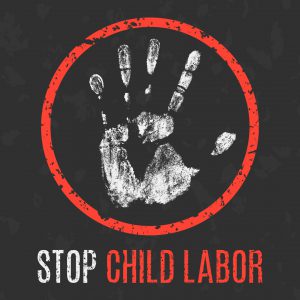What is Child Labour: The term child labour is often defined as work that deprives children of their childhood, their potential and dignity and that is harmful to physical and mental development.1
Work which that is classified as child labour: –
- Work that is mentally, physically, socially or morally dangerous and harmful to children.
- Interferes with their schooling.
- Depriving them of the opportunity to attend school.
- Obliging them to leave school permanently.
- Requiring them to attempt to combine school attendance with excessively long and heavy work.
Worst forms of child labour: – Has priority to be eliminated as defined by Article 3 International Labour Organisation Convention 182 (hereinafter ILO):
- All forms of slavery
- Child prostitution
- Illicit activities e.g. drug trafficking
- Hazardous work which will harm the health, safety or morals of children
Facts & Statistics: – 218 million children are in employment; among them 152 million are victims of child labour almost half 73 million work in hazardous conditions.
Child labour is mainly attributed in agriculture sector (71%), 17% in services and 12% in industrial sector.
Almost half of all 152 million children in child labour are aged 5-11 years old, 42 million (28%) are 12-14 and 37 million (24%) 13-17.
58% of all children in child labour and 62% of all children in hazardous work are boys. It appears that boys face a greater risk of child labour than girls however this may be a reflection of an under-reporting of girls work particularly in domestic child labour.
One in five children in Africa is involved in child labour making it the region where the risk of child labour the greatest followed by Asia and the Pacific.
Some children in child labour are working up to or more than 43 hours per week.
Between 2000-2012 governments were able to reduce child labour rates by a third from 250 million to 168 million. However new statistics released by ILO indicate that this trend is moving at much slower rate.
From 2012-2016 the number of children in child labour decreased to 152 million from 168 million. At this rate governments will not achieve the common goal to end child labour by 2025 as was set out in the sustainable development goals 2015.
School enrollment rates increase while child labour decreases; since 2000 governments have actively increased the number of children in school by 110 million making it less likely for children to be exploited.
Conventions in relation to child labour: – The ILO has two core conventions relation to child labour:
- Convention No.138 on the minimum age adopted 1973
- Convention No.182 on the worst forms of child labour adopted in 1999.
- Ratification of the UN Convention on the Rights of the Child (CRC) and its two optional protocols: optional protocol to the convention on the CRC on the involvement of the child in armed conflict; optional protocol to the convention on the CRC on the sale of the children, child prostitution and child pornography.
Policies & Recommendations: – Some of these recommendations are already in place but others are about to be implemented:
- Strong legal framework: Effective inspections and penalties for employers who exploit children.
- National Action Plans (NAP) to eliminate child labour: National, regional and international policies are a key tool to combat child labour.
- Cash Transfer Programs: Provide poor families with a guaranteed monthly income. For instance in Morocco payments of US $7 a month per child helped reduce child labour rates by a third, same goes for Microfinance programs as Humanium provides via its partner Hand in Hand India.
- UN Development Assistance Framework (UNDAF): It outlines the collective actions and strategies of the UN system to the achievement of national development goals.
- Common country assessment (CCA): A document which is both a process and a product that is used by the UN and its agencies to analyse the national development situation and identify key development issues.
- Existing international standards: Related to businesses and child labour. The UN Guiding Principles on Business and Human Rights and the Organisation for Economic Co-operation and Development (OECD) Guidelines for Multinational Enterprises explicitly state human right responsibilities of business but have no enforcement mechanism.
- Binding international standards: It must be a requirement for business to carry out due diligence. mandatory restrictions to prevent child labour.
Ending child labour interrupts cycles of poverty while strengthening families, communities and economies, let’s all act, now!
Read more about Humaniums projects: www.humanium.org/en
References
- http://www.ilo.org/ipec/facts/lang–en/index.htm
- http://www.ilo.org/global/topics/child-labour/lang–en/index.htm
- http://www.ilo.org/ipec/Regionsandcountries/lang–en/index.htm
- https://www.hrw.org/news/2017/09/19/progress-slows-ending-child-labor
- https://www.hrw.org/news/2016/06/06/global-profits-and-peril-child-labor
Written by:Igi Nderi



